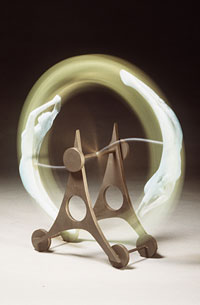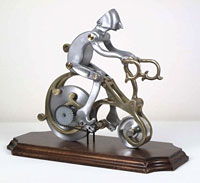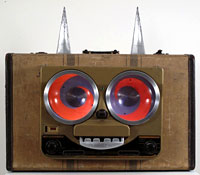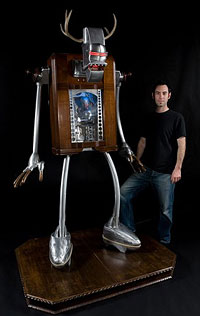Kinetic Art: Copper in Motion
 Chaotic Flyers by Rein Triefedlt
Chaotic Flyers by Rein TriefedltPhotograph by Cie Stroud
Kinetic art is the name given to art that has moving parts, but the work within that genre is remarkably diverse. For one thing, the movement in kinetic art can be driven by various sources of power - natural gusts of air, electricity, batteries, clockworks, liquids, or magnets. In other cases, the art is interactive, moving only from the action of an observer through the turn of a crank or the push of a finger. While the materials in kinetic art are as diverse as the power they use, metals such as copper and brass have long been a natural choice for this sculptural form of art.
Today's kinetic artists are pushing the envelope as they borrow from the latest technologies and partner with scientists to create pieces that utilize solar power, sound waves, and fiber optics.
It is believed that Russian sculptors Naum Gabo and Antoine Pevsner made up the term "kinetic art" in 1920 in the Realist Manifesto, a book in which they advised artists to let go of conventions. Although moving sculpture has been around since ancient Egypt, the sculpture that is generally considered to have begun the modern kinetic art movement is Marcel Duchamp's 1913 "Bicycle Wheel."
In the 1920s, Alexander Calder created the mobile, which is probably the most familiar type of kinetic art. Calder, George Rickey, and Jean Tinguely are among the most well-known kinetic artists of the 1950s and 1960s, an era which is often called the "Golden Age of Kinetic Art."
One thing is for certain: Adding movement to art creates a unique set of problems. Mobiles must be balanced in order to hang properly, and mechanical or wind-powered elements must operate without constructed pieces falling apart.
 Kinetic artist Rein Triefedlt with Flyer VI
Kinetic artist Rein Triefedlt with Flyer VIPhotograph by Wojtek Naczas
In 1969, some artists began subjecting their kinetic sculptures to the demands of a race. The first race held in Ferndale, California eventually became the Kinetic Grand Championship and expanded to a cross-country course that covers 41 miles with sand dunes and waterways. The race celebrated its 40th anniversary this year, and similar races are now held throughout the world.
Grounds for Sculpture in Hamilton, New Jersey launched an exhibit in 2006 called "Momentum," which featured the work of the American sculptors in the Kinetic Art Organization. New Jersey artist Rein Triefeldt founded the organization in 2000 with European artists Berward Frank and Ralfonso Gschwend.
While the Kinetic Art Organization is largely inactive today, Frank maintains the website Kineticus.org, which lists kinetic artists and exhibitions. The Kinetic Art Organization still hopes to someday build a museum in the U.S. "We've inherited a historically significant collection of kinetic art, and it's being stored in Florida right now," says Triefeldt. "One day, if we can form some sort of foundation so that we can sustain the museum, it will be built…. We have designs all ready that we could get somebody excited about," he says.
Triefeldt's initial interest in kinetic art began in college. One of his early pieces was a metaphorical lightning storm that was constructed so that it would actually rain inside the gallery when it was humid. Today, he concentrates primarily on environmental elements, such as solar-powered art. He has created cast bronze and stainless steel butterflies with wings that move on solar power. The wings are painted with very expensive paint that changes color with the light in order to replicate the iridescence of real butterfly wings.
In 2006, Triefeldt partnered with Dr. Rob Goldston, the Director of the Princeton Plasma Physics Laboratory at Princeton University, to create the aluminum "Stellarator," which he calls a "mechanism used to confine hot plasma with magnetic fields in order to sustain a controlled nuclear fusion reaction." Some of his earlier work consisted of bronze "impulse-driven" flyers, many of which were created for Cirque du Soleil. The pieces were purchased outright by Cirque and taken on tour for display and sale in a V.I.P. tent.
Currently, Triefeldt is in the planning stages for a solar project with the rock group War, which will be installed in the Ecuadorian Andes, where the majority of people live without reliable electricity. He also has initiated a solar tree project with a school in California, where the children have helped him with the designs. Unfortunately, funding for that project is currently stalled.
He makes tabletop models of most of his pieces before creating the full-scale versions, but unlike many artists, Triefeldt tries to transport his large work without deconstructing it. This usually involves hiring an art shipping company with an enormous crane truck.
 Cyclist, kinetic sculpture by Nemo Gould
Cyclist, kinetic sculpture by Nemo GouldPhotograph courtesy of Nemo Gould
California artist Nemo Gould, on the other hand, thinks immediately about how his sculptures can be deconstructed and reconstructed. "I've had to become something of a carnie," he says. "For my large sculptures, it needs to be possible for them to be assembled by a person who doesn't speak English on the other side of the world. It's the rule of thumb for making a large piece: A lot of electrical connections that cannot be attached backwards, asymmetrical bolt patterns so you cannot get the alignment wrong." He recently sold a large mixed media praying mantis sculpture featuring brass fitting to Ripley's Believe It or Not in Orlando, Florida.
Gould also had to adapt to the way observers respond to kinetic art, making his work particularly resilient. "People will look at it and say, 'That looks like its arm moves,' and they'll grab its arm and break it," he says.
Unlike Triefeldt, Gould's work is motorized. He generally creates playful robot-like puppets in which he often utilizes LED technology to produce light effects. "With motors, you can fight physics," he says. The sizes of the pieces vary from four inches to nine feet, although the average size is two feet.
Originally, Gould hoped to become an animator, but he lost interest when he learned more about the actual work that's involved. "It turned out with my temperament, picking up the mechanical knowledge necessary to make things move was actually the short road to where I wanted to go," he says. "I like having my hands dirty."
 Head Case, kinetic sculpture by Nemo Gould
Head Case, kinetic sculpture by Nemo GouldPhotograph courtesy of Nemo Gould
Gould's work is made entirely from found pieces, the majority of which are aluminum and brass, although he has begun to experiment with wood. "The pack rat mentality is a big feature for me for better or worse," he says. "This all started because I couldn't stop collecting things. It started reaching a critical mass where I finally saw there could be some purpose behind it."
Currently, he has four or five projects that are on hold because they're missing a piece that he hasn't yet found. "I collect stuff, and it piles up until I can start to see some relationships that make sense. There's no sketching, there's no drawing, there's no planning, there's no measuring." Of course, working with found metal makes commissioned work difficult because he can never promise to create something exactly to someone's specifications.
In contrast to the large-scale solar work of Triefeldt and the mechanized work of Gould, Maryland artist Gary (Chris) Christopherson, who goes by GChris, creates smaller copper mobiles, which sometimes also incorporate wood. What he has in common with Gould, however, is an inspiration from futuristic imagery. In fact, some of his pieces were used in an episode of the science fiction television show, "The X-Files," and one piece was purchased by the show's star, Gillian Anderson.
 Kinetic artist Nemo Gould with Little Big Man
Kinetic artist Nemo Gould with Little Big ManPhotograph courtesy of Nemo Gould
"I don't do mechanical kinetic. I generally do things by touch or by air," says GChris. He loves the synergy that occurs when an observer, particularly a child, must touch a piece in order to make it move. That motion sometimes also produces shadows and non-mechanized sound. His work today focuses on an expression of social issues and a vision of future sustainability. "How do we move from vulnerability to thriving?" he says. "The work tries to move from things not going so well to things going much better and how do we get there."
For a year, GChris ran his own art gallery in Georgetown, Washington, D.C., the only gallery there that was owned by the artist himself. The work of running a gallery took too much time away from creative pursuits, however, and GChris now focuses primarily on Internet sales of his work.
Triefeldt is now represented by Allen Sheppard Gallery in New York, but both GChris and Gould have found it difficult to do shows. Collectors already tend to buy less sculpture than wall art, but kinetic artists are at a particular disadvantage. Not only is it complicated to transport their work, but it is not the kind of work that individuals frequently buy for home display.
Still, the challenges and rewards of creating kinetic art are great. "Material advances are just making it better and better for kinetic artists," says Triefeldt. "So, the art can be much more complex than ever before."
Also in this Issue:
- Kinetic Art: Copper in Motion
- Anita DiPietro Designs
- Luster Metal Works: Transforming Metal
- Speaking Through Copper
- Automata: Contemporary Mechanical Sculpture
